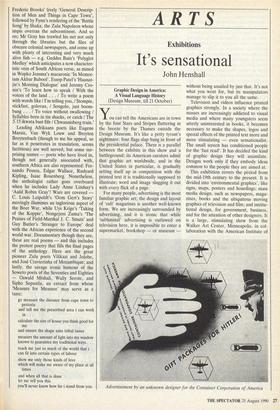ARTS
Exhibitions
It's sensational
John Henshall
Graphic Design in America: A Visual Language History (Design Museum, till 21 October)
You can tell the Americans are in town by the four Stars and Stripes fluttering in the breeze by the Thames outside the Design Museum. It's like a petty tyrant's nightmare: four flags slap bang in front of the presidential palace. There is a parallel between the exhibits in this show and a battleground: its American curators admit that graphic art worldwide, and in the United States in particular, is gradually setting itself up in competition with the printed text it is traditionally supposed to illustrate; word and image slugging it out with every flick of a page.
For many people, advertising is the most familiar graphic art; the design and layout of 'cult' magazines is another well-known form. We are increasingly surrounded by advertising, and it is ironic that while `subliminal' advertising is outlawed on television here, it is impossible to enter a supermarket, bookshop — or museum — without being assailed by just that. It's not what you went for, but its manipulators manage to slip it to you all the same.
Television and videos influence printed graphics strongly. In a society where the masses are increasingly addicted to visual media and where many youngsters seem utterly uninterested in books, it becomes necessary to make the shapes, logos and special effects of the printed text more and more stimulating — even sensationalist. The small screen has conditioned people for the 'fast read'. It has decided the kind of graphic design they will assimilate. Designs work only if they embody ideas common to the people they are aimed at.
This exhibition covers the period from the mid-19th century to the present. It is 'divided into 'environmental graphics', like signs, maps, posters and hoardings; mass media design, such as newspapers, maga- zines, books and the ubiquitous moving graphics of television and film; and institu- tional design, for government, business, and for the attention of other designers. It is a large, stimulating show from the Walker Art Center, Minneapolis, in col- laboration with the American Institute of Advertisement by an unknown designer for the Container Corporation of America Graphic Arts, New York. This is its only European venue.
Immediately striking is the influence exerted on American design (ne commer-
cial art) from the 1930s onwards by numer- ous leading designers from Eastern Europe, who brought with them such intellectual traditions as Cubism, Dada, De Stijl and the Bauhaus. What they sought in America was the artistic freedom which political repression had stolen from them at home. Men like Herbert Bayer, who became self-appointed spokesman for the Bauhaus in the United States, Will Burtin, with his gift for scientific and
technological design, and Ladislav Sutner, an early exponent of what is today called information technology, were already known in America, and soon found work and exerted influence.
A particularly important figure was Mehemed Fehmy Agha, who was born in the Ukraine to Turkish parents: he met Conde Nast and became art director of Vogue, Vanity Fair and other titles. He also seems to have hired half the other designers of his generation in the exhibi- tion at some point. The frontiers of photo- graphy in relation to design were pushed back by Laszlo Moholy-Nagy, who after graduation in Budapest joined the Con- structivists in Berlin, and Alexey Brodo- vitch, art director of Harper's Bazaar for 25 years, when he recruited Cartier- Bresson, Man Ray and Richard Avedon.
This European input is obvious through- out the show, even in the work of younger designers for whom the big names of the inter-war years were just part of their college studies. Gyorgy Kepes's Language of Vision (1941) remains a standard text at American design schools. Among native American greats represented here is Lester Beall, graphic designer for the Chicago Tribune and the first American commercial artist to have a one-man show at the Museum of Modern Art, New York.
Extraordinary projects seize one's atten- tion: Sussman/Prejza's 'environmental de- sign' for the 1984 Los Angeles Olympics, which 'illustrated' the city from the colum- nar `sonotubes' which created avenues between sporting and artistic sites down to the staff's uniforms. Richard Saul Wurman and the Understanding Business's revolu- tionary road atlases, highly visual city guides and ethnographical/commercial maps show tremendous inventiveness.
Propaganda posters like Cristos Sanakos's Vietnam one, showing a Stars and Stripes with a black rectangle for the stars and the simple message 'Send our boys home' below, and Art Chantry's 'Give Peace a Dance', showing Reagan and Gorbachev waltzing together, are vivid and memor- able.
Book covers proliferate, if some dis- appoint. One, superb in its simplicity, is by Ivan Chermayeff, saying simply 'This Book is about the work of Claes Oldenburg' in bright green on a cream background.
Lester Beall's telling posters for the Rural Electrification Administration and Massi- mo Vignello's black-on-yellow flyer for the National Parks, warning about grizzly bears, also stand out. The Design Museum has staged another first-class show. There's quite a nice cafe attached, too.











































 Previous page
Previous page